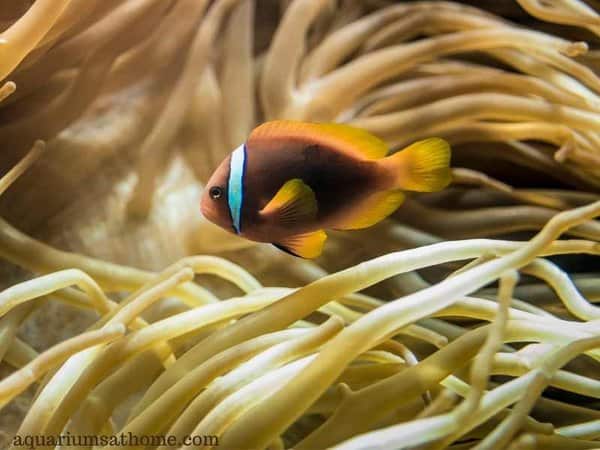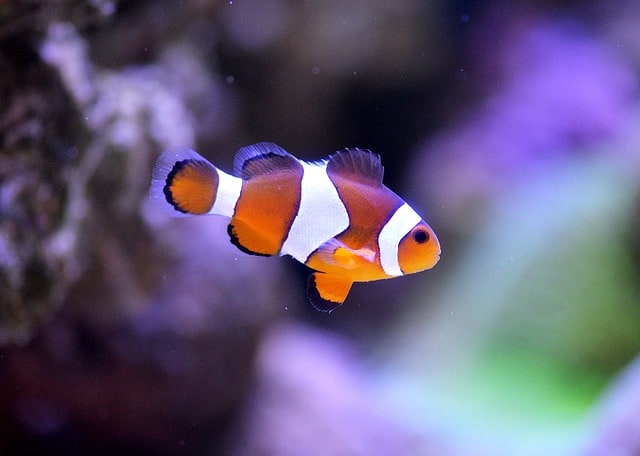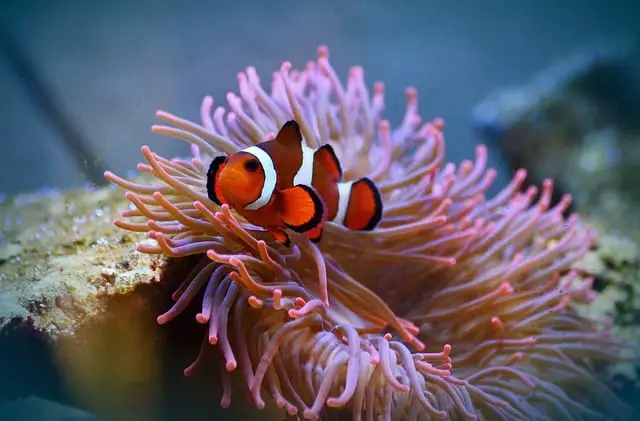As an aquarist, you may be contemplating a change from a freshwater aquarium to a saltwater tank. If clownfish is your species of choice, deciding which types to keep can be challenging. You must consider both size and temperament. For example, ‘can a black clownfish mate with an orange one?’
Captive-bred clownfish will breed with one another, regardless of color. You can keep a black clownfish with an orange one and they’ll bond, provided they’re of similar size and temperament. Even if both fish are males, the larger one will switch gender to female for procreation purposes.
Now that you know a black clownfish can easily mate with an orange one, let’s explore this topic further and in more detail. Together, we’ll learn how many clownfish you can keep together, how to encourage clownfish to pair up and breed in captivity, and how to properly care for clownfish offspring.
So, if you’re ready to ‘dive deeper’ into the aquatic world and breeding habits of the clownfish in captivity, then let’s begin!
Can Two Different Types of Clownfish Mate?
Different species of clownfish can easily breed with one another in a captivity – under the right aquatic conditions, that is. If you have two sexually mature clownfish living a clean, stress-free environment with ample food, they’ll likely pair up and mate in a saltwater tank.
Can You Pair Different Color Clownfish?
Though clownfish typically choose to pair with a fish of like size and appearance, they’ll breed with a different colored species if there are no other options. Their instinct to procreate and populate will drive them to seek out a viable mating companion, regardless of coloration.

Can Clownfish Crossbreed?
Clownfish can crossbreed, provided they’re of similar size and have reached sexual maturity. While crossbreeding in the wild is rare, it happens frequently in captivity when different species of clowns are kept together. The drive to reproduce takes over, regardless of species or coloration.
Will Offspring of Crossbred Clownfish be Fertile?
Offspring of captive crossbred clownfish will be fertile if properly cared for. Though it’s typical for hybrid fish to be less fertile than those of purebred decent, crossbred clownfish seem to be able to procreate with ease. That said, it’s best to breed clowns of the same species whenever possible.
Can Black and Orange Clownfish Live Together?
Black and orange clownfish can live together in captivity if they’re of like size and temperament. You can’t keep larger, more aggressive species like African (Clarke’s anemonefish), tomato, or maroon clowns with smaller, more docile types such as percula or ocellaris less they be bullied, even killed.
Can You Mix Black Percula and Orange Ocellaris Clownfish?
Since percula and ocellaris clownfish are similar in size and temperament, they can be kept together in the same aquarium. Mixing clownfish can be challenging so you must do your research in advance. Make sure the tank is large enough and the water parameters are conducive to each species.
Can You Keep an Odd Number of Clownfish Together?
It’s not recommended that you house odd numbers of clownfish in captivity. Clownfish instinctively pair up and mate for life. If you keep odd numbers together in the same tank, the mated pair will team up and bully the remaining fish.
Can Clownfish Change Color?
Clownfish typically change color as they age. Juveniles will start to appear brighter and more vibrantly hued as they reach sexual maturity. As adults, clownfish won’t change color unless they’re of advanced age or plagued by disease. Appearing dull or losing coloration is often a sign of stress and/or illness.
Can Clownfish Change Gender?
Clownfish are hermaphroditic, meaning they can spontaneously change gender for the purposes of procreation. In an environment of all males, the largest will switch sex to female and breed with the dominant male. Mating for life is typical of this species.
What are the Signs that Clownfish are Ready to Mate?
Signals of spawning behavior in clownfish include the female becoming thicker and wider in the midsection. This indicates that she’s getting ready to release her eggs. Both fish may begin to clean rocks with their mouths and fins in preparation for egg laying.
You’ll also notice the male twitching next to the female and both fish chasing each other around the tank. The female may also ‘attack’ the male and nip at his fins. Though this may appear aggressive, it’s a natural act and of no need for concern.

How to Breed Clownfish in Captivity?
To breed clownfish successfully in captivity, follow the steps listed below:
- Choose a mated pair from your local fish store. If they don’t have in stock, ask them to special order a bonded set for you.
- If you can’t get a mated pair, then try to get two clownfish to bond on your own. Begin by purchasing a couple of juveniles and placing them together in the same tank. As they age, the two will bond naturally. Even if both are males, the larger one will switch gender to female.
- Make sure the tank is clean and the water parameters are conducive to mating. Slightly warmer-than-usual conditions will encourage clownfish to breed.
- Add artificial plants and live rocks to the tank. Decorations not only help clownfish feel safe by providing hiding spots, but they also act as an area for fish to lay and care for their eggs.
- Ensure the aquarium light is functioning properly and set on a timer. Eight hours on during the day and off for the remaining sixteen hours will keep fish relaxed and encourage them to spawn.
- Provide your clownfish with protein-rich, high-quality food. Feeding your mated pair twice a day with enough edibles to be eaten in a two-minute time period will keep them well-nourished and promote spawning behavior.
- One you notice signs of breeding such as chasing each other, cleaning rocks, and enlarging of the female’s belly, keep an eye out for clownfish eggs. They appear circular, orange in color, and are usually attached to rocks. The male will also swim about the eggs and aerate them with his fins.
- Once the eggs have hatched, which takes seven to ten days, remove the fry and place them in a separate tank with the same water parameters as the main aquarium. Clownfish have been to eat their own offspring so you must separate the adults from the youngsters as soon as possible.
- To care for clownfish offspring, offer them phytoplankton such as rotifers for sustenance three times a day. As they begin to grow, provide them with meaty options including live brine shrimp and cut up bloodworms.
- Do 25-50% water changes daily to the hatchling tank – this keeps the water clean and clear which allows fry to better see the phytoplankton they need to eat.
- Observe the offspring tank daily and watch for signs of juvenile aging such as changing color and becoming brighter. Once the youngsters reach three months of age (or big enough not to be eaten), return them back to the main tank with their parents.
- Make sure the main tank has plenty of hiding places including live rock and anemones. Try to keep only even number of clownfish together since they pair up as they mature and the odd ones out will get harassed.
Final Thoughts
To sum-up, different species of clownfish will typically breed with one another in captivity, regardless of coloration. If you keep a black clownfish with an orange one in a clean, stress-free aquatic environment, they’ll likely pair up and reproduce with ease so long as they’re of like size and temperament.
I hope this article has been of help in providing the information you seek regarding clownfish breeding. Thanks for reading and good luck with your aquarist hobby!
Recommended Posts
Clown Fish Tank Set Up for Beginners
Can You Have 3 Clownfish in a Tank?






